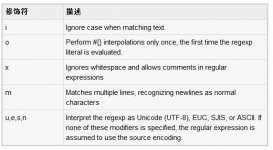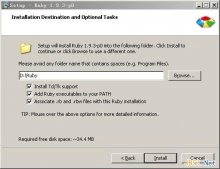使用 UTF-8 作为源文件编码。
每个缩进级别使用两个 spaces (又名软 tabs). 不要硬 tabs
|
1
2
3
4
5
6
7
8
9
|
# bad - four spacesdef some_method do_somethingend# gooddef some_method do_somethingend |
使用 Unix-风格 换行符。(*BSD/Solaris/Linux/OSX 用户被为默认涵盖,Windows 用户必须特别小心.)
- \n是换行,英文是LineFeed,ASCII码是0xA。
- \r是回车,英文是Carriage Return ,ASCII码是0xD。
- windows下enter是 \n\r,unix下是\n,mac下是\r
如果你正在使用 Git 你可能会想要添加下面的配置设置来保护你的项目(避免)Windows 蔓延过来的换行符:
|
1
|
$ git config --global core.autocrlf true |
不用使用 ; 来分割语句和表达式。以此推论 - 一行使用一个表达式
|
1
2
3
4
5
6
7
8
9
10
11
12
|
# bad puts 'foobar'; # superfluous semicolon puts 'foo'; puts 'bar' # two expression on the same line # good puts 'foobar' puts 'foo' puts 'bar' puts 'foo', 'bar' # this applies to puts in particular |
对于没有内容的类定义,尽可能使用单行类定义形式.
|
1
2
3
4
5
6
7
8
9
|
# bad class FooError < StandardError end # okish class FooError < StandardError; end # good FooError = Class.new(StandardError) |
避免单行方法。即便还是会受到一些人的欢迎,这里还是会有一些古怪的语法用起来很容易犯错.
无论如何 - 应该一行不超过一个单行方法.
|
1
2
3
4
5
6
7
8
9
10
11
12
13
14
15
16
|
# bad def too_much; something; something_else; end # okish - notice that the first ; is required def no_braces_method; body end # okish - notice that the second ; is optional def no_braces_method; body; end # okish - valid syntax, but no ; make it kind of hard to read def some_method() body end # good def some_method body end |
空方法是这个规则的例外。
|
1
2
|
# gooddef no_op; end |
操作符旁的空格,在逗号,冒号和分号后;在 { 旁和在 } 之前,大多数空格可能对 Ruby 解释(代码)无关,但是它的恰当使用是让代码变得易读的关键。
|
1
2
3
4
|
sum = 1 + 2a, b = 1, 21 > 2 ? true : false; puts 'Hi'[1, 2, 3].each { |e| puts e } |
唯一的例外是当使用指数操作时:
|
1
2
3
4
5
|
# bade = M * c ** 2# goode = M * c**2 |
{ 和 } 值得额外的澄清,自从它们被用于 块 和 hash 字面量,以及以表达式的形式嵌入字符串。
对于 hash 字面量两种风格是可以接受的。
|
1
2
3
4
5
|
# good - space after { and before }{ one: 1, two: 2 }# good - no space after { and before }{one: 1, two: 2} |
第一种稍微更具可读性(并且争议的是一般在 Ruby 社区里面更受欢迎)。
第二种可以增加了 块 和 hash 可视化的差异。
无论你选哪一种都行 - 但是最好保持一致。
目前对于嵌入表达式,也有两个选择:
|
1
2
3
4
5
|
# good - no spaces"string#{expr}"# ok - arguably more readable"string#{ expr }" |
第一种风格极为流行并且通常建议你与之靠拢。第二种,在另一方面,(有争议)更具可读性。
如同 hash - 选取一个风格并且保持一致。
没有空格 (, [之后或者 ], )之前。
|
1
2
3
4
5
6
7
8
9
10
|
some(arg).other[1, 2, 3].length! 之后没有空格 .# bad! something# good!something |
when和case 缩进深度一致。我知道很多人会不同意这点,但是它是"The Ruby Programming Language" 和 "Programming Ruby"中公认的风格。
|
1
2
3
4
5
6
7
8
9
10
11
12
13
14
15
16
17
18
19
20
21
22
23
24
25
26
27
28
29
30
31
32
33
34
|
# bad case when song.name == 'Misty' puts 'Not again!' when song.duration > 120 puts 'Too long!' when Time.now.hour > 21 puts "It's too late" else song.play end # good case when song.name == 'Misty' puts 'Not again!' when song.duration > 120 puts 'Too long!' when Time.now.hour > 21 puts "It's too late" else song.play end case when song.name == 'Misty' puts 'Not again!' when song.duraton > 120 puts 'Too long!' when Time.now > 21 puts "It's too late" else song.play end |
当赋值一个条件表达式的结果给一个变量时,保持分支的缩排在同一层。
|
1
2
3
4
5
6
7
8
9
10
11
12
13
14
15
16
17
18
19
20
21
22
23
24
25
26
27
28
29
30
31
32
33
34
35
36
37
38
39
40
41
42
43
44
45
46
47
48
49
|
# bad - pretty convolutedkind = case yearwhen 1850..1889 then 'Blues'when 1890..1909 then 'Ragtime'when 1910..1929 then 'New Orleans Jazz'when 1930..1939 then 'Swing'when 1940..1950 then 'Bebop'else 'Jazz'endresult = if some_cond calc_somethingelse calc_something_elseend# good - it's apparent what's going onkind = case year when 1850..1889 then 'Blues' when 1890..1909 then 'Ragtime' when 1910..1929 then 'New Orleans Jazz' when 1930..1939 then 'Swing' when 1940..1950 then 'Bebop' else 'Jazz' endresult = if some_cond calc_something else calc_something_else end# good (and a bit more width efficient)kind = case year when 1850..1889 then 'Blues' when 1890..1909 then 'Ragtime' when 1910..1929 then 'New Orleans Jazz' when 1930..1939 then 'Swing' when 1940..1950 then 'Bebop' else 'Jazz' endresult = if some_cond calc_something else calc_something_else end |
在方法定义之间使用空行并且一个方法根据逻辑段来隔开。
|
1
2
3
4
5
6
7
8
9
10
11
|
def some_method data = initialize(options) data.manipulate! data.result end def some_methods result end |
避免在一个方法调用的最后一个参数有逗号,特别是当参数不在另外一行。
|
1
2
3
4
5
6
7
8
9
10
11
12
|
# bad - easier to move/add/remove parameters, but still not preferred some_method( size, count, color, ) # bad some_method(size, count, color, ) # good some_method(size, count, color) |
当给方法的参数赋默认值时,在 = 两边使用空格:
|
1
2
3
4
5
6
7
8
9
|
# bad def some_method(arg1=:default, arg2=nil, arg3=[]) # do something... end # good def some_method(arg1 = :default, arg2 = nil, arg3 = []) # do something... end |
虽然几本 Ruby 书建议用第一个风格,不过第二个风格在实践中更为常见(并可争议地可读性更高一点)。
避免在不需要的时候使用行继续符 \ 。实践中,
除非用于连接字符串, 否则避免在任何情况下使用行继续符。
|
1
2
3
4
5
6
7
8
9
10
|
# badresult = 1 - \ 2# good (but still ugly as hell)result = 1 \ - 2long_string = 'First part of the long string' \ ' and second part of the long string' |
采用连贯的多行方法链式风格。在 Ruby 社区有两种受欢迎的风格,它们都被认为很好
- . 开头(选项 A) 和 尾随 . (选项 B) 。
(选项 A) 当一个链式方法调用需要在另一行继续时,将 . 放在第二行。
|
1
2
3
4
5
6
7
|
# bad - need to consult first line to understand second line one.two.three. four # good - it's immediately clear what's going on the second line one.two.three .four |
(选项 B) 当在另一行继续一个链式方法调用,将 . 放在第一行来识别要继续的表达式。
|
1
2
3
4
5
6
7
|
# bad - need to read ahead to the second line to know that the chain continues one.two.three .four # good - it's immediately clear that the expression continues beyond the first line one.two.three. four |
在这里可以发现有关这两个另类风格的优点的讨论。
如果一个方法调用的跨度超过了一行,对齐它们的参数。当参数对齐因为行宽限制而不合适,
在第一行之后单缩进也是可以接受的。
|
1
2
3
4
5
6
7
8
9
10
11
12
13
14
15
16
17
18
19
20
21
22
23
24
25
26
27
28
29
30
31
|
# starting point (line is too long) def send_mail(source) Mailer.deliver(to: 'bob@example.com', from: 'us@example.com', subject: 'Important message', body: source.text) end # bad (double indent) def send_mail(source) Mailer.deliver( to: 'bob@example.com', from: 'us@example.com', subject: 'Important message', body: source.text) end # good def send_mail(source) Mailer.deliver(to: 'bob@example.com', from: 'us@example.com', subject: 'Important message', body: source.text) end # good (normal indent) def send_mail(source) Mailer.deliver( to: 'bob@example.com', from: 'us@example.com', subject: 'Important message', body: source.text ) end |
对齐多行跨度的 array literals 的元素。
|
1
2
3
4
5
6
7
8
9
10
11
12
13
14
|
# bad - single indent menu_item = ['Spam', 'Spam', 'Spam', 'Spam', 'Spam', 'Spam', 'Spam', 'Spam', 'Baked beans', 'Spam', 'Spam', 'Spam', 'Spam', 'Spam'] # good menu_item = [ 'Spam', 'Spam', 'Spam', 'Spam', 'Spam', 'Spam', 'Spam', 'Spam', 'Baked beans', 'Spam', 'Spam', 'Spam', 'Spam', 'Spam' ] # good menu_item = ['Spam', 'Spam', 'Spam', 'Spam', 'Spam', 'Spam', 'Spam', 'Spam', 'Baked beans', 'Spam', 'Spam', 'Spam', 'Spam', 'Spam'] |
大数值添加下划线来提高它们的可读性。
|
1
2
3
4
5
|
# bad - how many 0s are there?num = 1000000# good - much easier to parse for the human brainnum = 1_000_000 |
使用 RDoc 以及它的惯例来撰写 API 文档。注解区块及 def 不要用空行隔开。
每一行限制在 80 个字符内。
避免行尾空格。
不要使用区块注释。它们不能由空白引导(=begin 必须顶头开始),并且不如普通注释容易辨认。
|
1
2
3
4
5
6
7
8
9
|
# bad== begincomment lineanother comment line== end# good# comment line# another comment line |
在 API 文档中使用 RDoc和它的公约。不要在注释代码块和def之间加入空行。
保持每一行少于80字符。
避免尾随空格。




